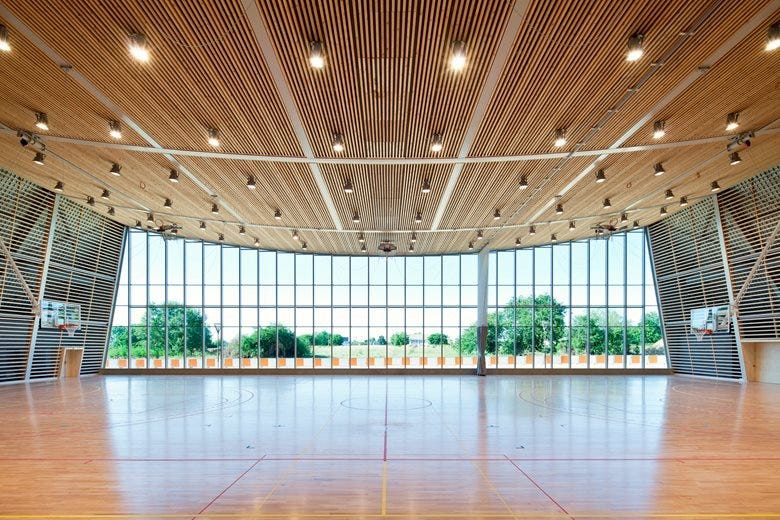Sustainability in Sports Facilities
6 minute read · Issue Number 76 · July 9th, 2021
Welcome to another weekly edition of Sports-Tech Biz! Every Friday, we learn about intriguing topics related to sports, business, and technology. If you’re reading this online or in a forwarded email, sign up for the newsletter:
Amigos,
A while ago I wrote a piece about sports facilities.
It was such a fun topic to read and write about, so I decided to jump into it again.
This time, we’ll deep dive into the sustainability elements of it.
Let’s get after it!
Sustainability in Sports Facilities
Before we learn about the practices that make sports facilities sustainable – let’s understand what sustainability actually means.
Something sustainable can be maintained at a specific state and can avoid wasting natural resources to maintain its balance.
Why is this concept important?
Our generation is not the first and will most likely not be the last to walk the earth, so we must take care of this planet for future generations.
Energy Efficiency
More than 40% of the energy used in the world is in buildings, and most of it comes from burning fossil fuels such as coal, oil, and natural gas.
These are not only limited resources but also create tons of emissions that hurt the environment.
Don’t believe me? Ask Elon Musk.
Sustainable energies provided by solar and wind are great alternatives that are slowly rising in many industries.
Nevertheless, sports facilities are exploring creative practices to save energy and help as much as they can through daylighting, adaptive facades, displaced ventilation, and others:
Daylighting
Daylighting of sports facilities has proven to be natural and energy-efficient.
Glazed walls or roofs in buildings or swimming pools are famous as they can also act as windows for those facilities. Besides, they make the place look really cool – check out how beautiful the new football stadium in LA is with an all-glass roof:
Adaptive Facades
Ideally, architects and engineers need to fabricate ‘smart solutions’ through the facilities.
For instance, create daylight to the point that would not affect the glare or eyesight of the fans watching or athletes performing.
How?
With adaptive elements for facilities:
Windows
Metal sheets
Plastic or glass layers.
Those techniques not only control the lighting, but they can also be very efficient in conserving the heat in the winter, preventing humidity in swimming pools, and creating the environment needed for each sport/practice.
Displaced Ventilation
To balance temperatures and contaminant levels, classic sports halls and gymnasiums ventilate the facilities by blowing cool air through the ceiling or wall.
However, this is inefficient because it leads to uneven temperatures, inadequate ventilation, and background noise.
The solution?
Displaced ventilation.
This method distributes conditioned air at low velocity through floor terminals.
As cool air floods into the room close to the floor, the room’s heat sources lift the air, and it passes through the occupied zone, to be exhausted on top.
The video below explains it so well. It’s honestly too long to watch (LOL) – but the first few minutes get you hypnotized, and you’ll understand the concept very fast.
Displaced ventilation is not only more efficient, but it also benefits people’s health and extends the life of furnishings, fittings, and expensive equipment.
The Bottom Line
By becoming more aware of the costs and impact of energy, waste, and recycling – we understand the value of sustainability.
In sports, new and remodeled facilities are all including sustainable elements (such as the ones we learned today) in their designs.
My advice?
Don’t only learn about those concepts; apply them in your life as well!
Are you building your next house? Add some daylighting.
Moving offices? Look for displaced ventilation.
We have to take care of this world; it’s the only one we have!
(for now… 😉 )
🎙 Halftime Snack of the Week
The 55th episode of The Halftime Snacks Podcast features yet another remarkable guest — Sanjit Atwal!
Sanj is the former co-founder of Squawka (rings a bell?), and he currently runs Halfspace.
We snacked about:
Product vs. distribution, the advertising industry, lessons from building, running, and selling Squawka, sports marketing, entrepreneurship & content, and so much more.
Listen on Apple | Spotify | Google
QUICKIES
🚲 What’s Next for Peloton After a Rocky, Record-Setting Year; The great analysis on Peloton in the connected fitness market mixed with Liam’s engaging writing style makes this one a must-read.
Bonus
On the emoji scale, how much did you enjoy today’s newsletter?
🙄 | 😐 | 🙂 | 😃 | 🤩
Until next week,
Ronen Ainbinder
Twitter: @Ronenain
Website: ronenainbinder.com
Book a call with me: superpeer.com/ronen
-
Sports-Tech Biz
Twitter: @sports_techbiz
Instagram: @sportstechbiz
Read more: sportstechbiz.substack.com.
-
Halftime Snacks Podcast











